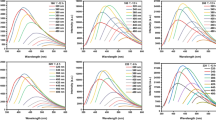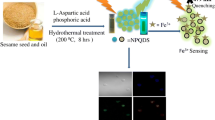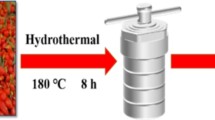Abstract
An economical and eco-friendly hydrothermal method for the preparation of nitrogen-doped carbon quantum dots (N-CQDs) was studied with rambutan peel and lysine. The morphology, structure, and optical properties of N-CQDs were characterized by transmission electron microscopy, Fourier transform infrared spectrometry, X-ray powder diffractometer, X-ray photoelectron spectrometry, and UV spectrophotometry. The synthesized N-CQDs have excellent characteristics such as strong fluorescence, good dispersion, high stability, and excellent water solubility. The absolute fluorescence quantum yield is 1.02%, the average particle size is 1.63 nm, and the maximum excitation wavelength is 340 nm. The maximum emission wavelengths are 430 nm and 800 nm. As a quencher, lornoxicam (LNX) was used to quench the fluorescence of N-CQDs with the mechanism of inner filter effect. The fluorescence ratio of N-CQDs (F430/F800) shows a good linear relationship to the concentration of LNX. The linear range and the detection limit of LNX are 0.01‒100 and 0.003 μmol/L, respectively. An effective ratiometric fluorescence probe for the detection of LNX was constructed. The method has the advantages of low detection limit, high sensitivity, wide linear range, and can be applied to the determination of LNX in real samples. Moreover, according to the excitation-dependent fluorescence behavior, dual-wavelength emission, and biocompatibility of N-CQDs, it has been applied to cell imaging.
Graphical abstract











Similar content being viewed by others
References
Sahoo SK, Giri RK, Patil SV, Behera AR, Mohapatra R (2012) Development of ultraviolet spectrophotometric method for analysis of lornoxicam in solid dosage forms. Tropical J Pharma Res 11:269–273
Abdellatif AAH, Hamd MAE, Salman KH, Rahim AMAE, Maghrabey ME, Tawfeek HM (2020) Integrative physicochemical and HPLC assessment studies for the inclusion of lornoxicam in buffalo’s milk fat globules as a potential carrier delivery system for lipophilic drugs. Microchem J 152:104321
Kim YH, Ji HY, Park ES, Chae SW, Lee HS (2007) Liquid chromatography-electrospray lonization tandem mass spectrometric determination of lornoxicam in human plasma. Arch Pharm Res 30:905–910
Ghoneim MM, Beltgi AM, Radi A (2002) Square-wave adsorptive stripping voltammetric determination of the anti-inflammatory drug lornoxicam. Anal Sci 18:183–186
Rizk M, Toubar SS, Elshahed MS (2012) Determination of some non-steroidal anti-inflammatory drugs through quenching the fluorescence of lanthanide tris complex. Eurasian J Anal Chem 7:13–27
Yang S, Lu F, Liu Y, Ning Y, Tian S, Zuo P, Ji X, He Z (2021) Quantum dots-based hydrogel microspheres for visual determination of lactate and simultaneous detection coupled with microfluidic device. Talanta 171:106801
Jiang X, Qin D, Mo G, Feng J, Zheng X, Deng B (2019) Facile preparation of boron and nitrogen codoped green emission carbon quantum dots for detection of permanganate and captopril. Anal Chem 91:11455–11460
Cheng S, Zhang J, Liu Y, Wang Y, Xiao Y, Zhang Y (2021) One-step synthesis of N, S-doped carbon dots with orange emission and their application in tetracycline antibiotics, quercetin sensing, and cell imaging. Microchim Acta 188:325
Ni P, Li Q, Xu C, Lai H, Bai Y, Chen T (2019) Optical properties of nitrogen and sulfur codoped carbon dots and their applicability as fluorescent probes for living cell imaging. Appl Surf Sci 494:377–383
Cailotto S, Amadio E, Facchin M, Selva M, Pontoglio E, Rizzolio F, Riello P, Toffoli G, Benedetti A, Perosa A (2018) Carbon dots from sugars and ascorbic acid: role of the precursors on morphology, properties, toxicity, and drug uptake. ACS Med Chem Lett 9:832–837
Yu C, Qin D, Jiang X, Zheng X, Deng B (2021) Facile synthesis of bright yellow fluorescent nitrogen-doped carbon quantum dots and their applications to an off–on probe for highly sensitive detection of methimazole. Microchem J 168:106480
Zhang H, You J, Wang J, Dong X, Guan R, Cao D (2020) Highly luminescent carbon dots as temperature sensors and “off-on” sensing of Hg2+ and biothiols. Dyes Pigments 173:107950
Zhu Z, Lin X, Wu L, Zhao C, Li S, Liu A, Lin X, Lin L (2019) Nitrogen-doped carbon dots as a ratiometric fluorescent probe for determination of the activity of acid phosphatase, for inhibitor screening, and for intracellular imaging. Microchim Acta 186:558
Long R, Tang C, Li T, Tong X, Tong C, Guo Y, Gao Q, Wu L, Shi S (2020) Dual-emissive carbon dots for dual-channel ratiometric fluorometric determination of pH and mercury ion and intracellular imaging. Microchim Acta 187:307
Yu C, Jiang X, Qin D, Mo G, Zheng X, Deng B (2019) Facile syntheses of S, N-codoped carbon quantum dots and their applications to a novel off-on nanoprobe for detection of 6-thioguanine and its bioimaging. ACS Sustain Chem Eng 7:16112–16120
Huang H, Lv J-J, Zhou D-L, Bao N, Xu Y, Wang A-J, Feng J-J (2013) One-pot green synthesis of nitrogen-doped carbon nanoparticles as fluorescent probes for mercury ions. RSC Adv 3:21691
Yao D, Liang A, Jiang Z (2019) A fluorometric clenbuterol immunoassay using sulfur and nitrogen doped carbon quantum dots. Microchim Acta 186:323
Li X, Hu Y, Li X, Ma H (2019) Mitochondria-immobilized near-infrared ratiometric fluorescent pH probe to evaluate cellular mitophagy. Anal Chem 91:11409–11416
Chen Z, Xu X, Meng D, Jiang H, Zhou Y, Feng S, Mu Z, Yang Y (2020) Dual-emitting N/S-doped carbon dots-based ratiometric fluorescent and light scattering sensor for high precision detection of Fe (III) ions. J Fluoresc 30:1007–1013
Wu L, Long R, Li T, Tang C, Tong X, Guo Y, Shi S, Xiang H, Tong C (2020) One-pot fabrication of dual-emission and single-emission biomass carbon dots for Cu2+ and tetracycline sensing and multicolor cellular imaging. Anal Bioanal Chem 412:7481–7489
Liu Z, Jin W, Wang F, Li T, Nie J, Xiao W, Zhang Q, Zhang Y (2019) Ratiometric fluorescent sensing of Pb2+ and Hg2+ with two types of carbon dot nanohybrids synthesized from the same biomass. Sensor Actuat B-Chem 296:126698
Wei Y, Wang H, Sun S, Tang L, Cao Y, Deng B (2016) An ultrasensitive electrochemiluminescence sensor based on reduced graphene oxide-copper sulfide composite coupled with capillary electrophoresis for determination of amlodipine besylate in mice plasma. Biosens Bioelectron 86:714–719
Sun D, Liu T, Wang C, Yang L, Yang S, Zhuo K (2020) Hydrothermal synthesis of fluorescent carbon dots from gardenia fruit for sensitive on-off-on detection of Hg2+ and cysteine. Spectrochim Acta A 240:118598
Liu E, Li D, Zhou X, Zhou G, Xiao H, Zhou D, Tian P, Guo R, Qu S (2019) Highly emissive carbon dots in solid state and their applications in light-emitting devices and visible light communication. ACS Sustain Chem Eng 7:9301–9308
Pandey SC, Kumar A, Sahu SK (2020) Single step green synthesis of carbon dots from murraya koenigii leaves; a unique turn-off fluorescent contrivance for selective sensing of Cd (II) ion. J Photoch Photobio A 400:112620
Xu S, He X, Huang Y, Liu X, Zhao L, Wang X, Sun Y, Ma P, Song D (2020) Lysosome-targeted ratiometric fluorescent sensor for monitoring pH in living cells based on one-pot-synthesized carbon dots. Microchim Acta 187:478
Zhang R, Fan Z (2020) Nitrogen-doped carbon quantum dots as a “turn off-on” fluorescence sensor based on the redox reaction mechanism for the sensitive detection of dopamine and alpha lipoic acid. J Photoch Photobio A 392:112438
Zhu X, Yu J, Yan Y, Song W, Hai X (2020) One-pot alkali cutting-assisted synthesis of fluorescence tunable amino-functionalized graphene quantum dots as a multifunctional nanosensor for sensing of pH and tannic acid. Talanta 236:122874
Meng H-L, Lin S-Y, Feng J-J, Zhang L, Wang A-J (2022) Coordination regulated pyrolysis synthesis of ultrafine FeNi/(FeNi)9S8 nanoclusters/nitrogen, sulfur-codoped graphitic carbon nanosheets as efficient bifunctional oxygen electrocatalysts. J Colloid Interface Sci 610:573–582
Sun R-M, Zhang L, Feng J-J, Fang K-M, Wang A-J (2022) In situ produced Co9S8 nanoclusters/Co/Mn-S, N multi-doped 3D porous carbon derived from eriochrome black T as an effective bifunctional oxygen electrocatalyst for rechargeable Zn-air batteries. J Colloid Interface Sci 608:2100–2110
Bai J, Chen X, Yuan G, Zhang L, Huang Z, Ren L (2021) A novel nitrogen-doped dual-emission carbon dots as an effective fluorescent probe for ratiometric detection dopamine. NANO 16:2150030
Liu Q, Dong Z, Hao A, Guo X, Dong W (2021) Synthesis of highly fluorescent carbon dots as a dual-excitation rationmetric fluorescent probe for the fast detection of chlorogenic acid. Talanta 221:121372
Wang R, Wang X, Sun Y (2017) One-step synthesis of self-doped carbon dots with highly photoluminescence as multifunctional biosensors for detection of iron ions and pH. Sens Actuat B-Chem 241:73–79
Li Y, Gao F, Gao F, Shan F, Bian J, Zhao C (2009) Study on the interaction between 3 flavonoid compounds and α-amylase by fluorescence spectroscopy and enzymatic kinetics. J Food Sci 74:199–203
Yue X, Zhou Z, Li M, Jie M, Xu B, Bai Y (2022) Inner-filter effect induced fluorescent sensor based on fusiform Al-MOF nanosheets for sensitive and visual detection of nitrofuran in milk. Food Chem 367:130763
Yue X, Li Y, Xu S, Li J, Li M, Jiang L, Jie M, Bai Y (2022) A portable smartphone-assisted ratiometric fluorescence sensor for intelligent and visual detection of malachite green. Food Chem 371:131164
Taha EA, Salama NN, Fattah LE-SA (2006) Spectrofluorimetric and spectrophotometric stability-indicating methods for determination of some oxicams using 7-Chloro-4-nitrobenz-2-oxa-1,3-diazole (NBD-Cl). Chem Pharm Bull 54:653–658
Abdel-Wadood HM (2008) Spectrofluorimetric method for determination of some oxicams using potassium bromate. Bull Pharm Sci 31:169–181
Yu C, Qin D, Jiang X, Zheng X, Deng B (2021) N-doped carbon quantum dots from osmanthus fragrans as a novel off-on fluorescent nanosensor for highly sensitive detection of quercetin and aluminium ion, and cell imaging. J Pharmaceut Biomed Anal 192:113673
Huang H, Xu Y, Tang C-J, Chen J-R, Wang A-J, Feng J-J (2014) Facile and green synthesis of photoluminescent carbon nanoparticles for cellular imaging. New J Chem 38:784
Yu L, Feng L, Xiong L, Li S, Xu Q, Pan X, Xiao Y (2021) Rational design of dual-emission lanthanide metal−organic framework for visual alkaline phosphatase activity assay. ACS Appl Mater Interfaces 13:11646–11656
Tang C, Long R, Tong X, Guo Y, Tong C, Shi S (2021) Dual-emission biomass carbon dots for near-infrared ratiometric fluorescence determination and imaging of ascorbic acid. Microchem J 164:106000
Hua J, Mu Z, Hua P, Wang M, Qin K (2020) Ratiometric fluorescence nanoprobe for monitoring of intracellular temperature and tyrosine based on a dual emissive carbon dots/gold nanohybrid. Talanta 219:1121279
Miao S, Liang K, Zhu J, Yang B, Zhao D, Kong B (2020) Hetero-atom-doped carbon dots: doping strategies, properties and applications. Nano Today 33:100879
Naksen P, Jarujamrus P, Anutrasakda W, Promarak V, Zhang L, Shen W (2022) Old silver mirror in qualitative analysis with new shoots in quantification: nitrogen-doped carbon dots (N-CDs) as fluorescent probes for “off-on” sensing of formalin in food samples. Talanta 236:122862
Acknowledgements
We acknowledge the support received from the National Natural Science Foundation of China (22164004, 21765004) and Guangxi Science Foundation of China (2019GXNSFAA245076).
Author information
Authors and Affiliations
Corresponding author
Ethics declarations
Conflict of interest
The authors declare no competing of interests.
Additional information
Publisher's note
Springer Nature remains neutral with regard to jurisdictional claims in published maps and institutional affiliations.
Supplementary Information
Below is the link to the electronic supplementary material.
Rights and permissions
About this article
Cite this article
Wu, Y., Qin, D., Meng, S. et al. Carbon quantum dots with blue/near infrared emissions for ratiometric fluorescent lornoxicam sensing and bio-imaging. Microchim Acta 189, 157 (2022). https://doi.org/10.1007/s00604-022-05262-0
Received:
Accepted:
Published:
DOI: https://doi.org/10.1007/s00604-022-05262-0




